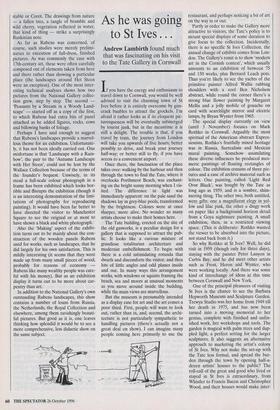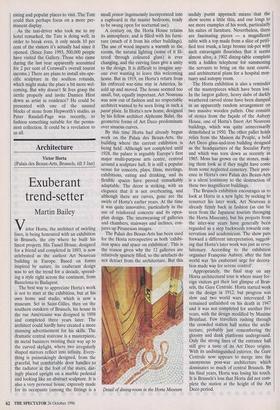As he was going to St Ives . . .
Andrew Lambirth found much that was fascinating on his visit to the Tate Gallery in Cornwall If you have the energy and enthusiasm to travel down to Cornwall, you would be well advised to visit the charming town of St Ives before it is entirely overcome by gim- crack baubles to attract the grockels. I'm afraid it rather looks as if its eloquent pic- turesqueness will be eventually submerged by tourist junk, but in the meantime it is still a delight. The trouble is that, if you travel by train, the journey from London will take you upwards of five hours; better possibly to drive, and break your journey half-way; or better still to fly, if you have access to a convenient airport.
Once there, the fascination of the place takes over: walking by the harbour and then through the town to find the Tate, where it overlooks Porthmeor Beach, was enchant- ing on the bright sunny morning when I vis- ited. The difference in light was immediately apparent: on the pale sand the shadows lay in grey-blue pools, transformed by the brightness. Colours were at once sharper, more alive. No wonder so many artists choose to make their homes here.
The Tate building, erected on the site of the old gasworks, is a peculiar design for a gallery that is supposed to attract the pub- lic. It looks like a curious mixture of grandiose totalitarian architecture and modernist embellishment. To begin with there is a cold intimidating rotunda that dwarfs and discomforts the visitor, and then lots of little angles and odd planes inside and out. In many ways this arrangement works, with windows or squints framing the beach, sea and moors at unusual moments as you move around inside the building, while the main views are marvellous.
But the museum is presumably intended as a display case for art and the art comes a poor third. First, people will want to look out, rather than in, and, second, the archi- tecture is not particularly sympathetic to handling pictures (there's actually not a great deal on show). I can imagine many people coming here primarily to use the restaurant, and perhaps noticing a bit of art on the way in or out.
Partly in order to make the Gallery more attractive to visitors, the Tate's policy is to mount special displays of some duration to give focus to the collection. Incidentally, there is no specific St Ives Collection, the annual change of exhibits comes from Lon- don. The Gallery's remit is to show 'modern art in the Cornish context', which usually amounts to an exhibition of between 75 and 150 works, plus Bernard Leach pots. Thus you're likely to see the yachts of the primitive painter Alfred Wallis rubbing shoulders with a cool Ben Nicholson abstract, while round the corner there's a strong blue flower painting by Margaret Mellis and a jolly mobile of gouache on card with searchlight mirror and electric lamps, by Bryan Wynter from 1965.
The special display currently on view (until 3 November) focuses on Mark Rothko in Cornwall. Arguably the most spiritual of the American abstract Expres- sionists, Rothko's fruitfully mixed heritage was in Russia, Surrealism and Mexican mural painting. Somehow assimilating these diverse influences he produced mes- meric paintings of floating rectangles of colour. The exhibition consists of three pic- tures and a case of archive material such as letters. One painting, called 'Light Red Over Black', was bought by the Tate as long ago as 1959, and is a sombre, shim- mering thing. The other two, both untitled, were gifts: one a magnificent elegy in yel- low and lilac pink, the other a dingy work on paper like a background horizon detail from a Goya nightmare painting. A small exhibition, then, in a restricted viewing space. (This is deliberate: Rothko wanted the viewer to be absorbed into the picture, not stand back from it.) So why Rothko at St Ives? Well, he did visit in 1959 (though only for three days), staying with the painter Peter Lanyon in Carbis Bay, and he did meet other artists such as Frost, Heron and Wynter, who were working locally. And there was some kind of interchange of ideas at this time between Cornwall and New York.
One of the principal pleasures of visiting St Ives is the chance to see the Barbara Hepworth Museum and Sculpture Garden. Trewyn Studio was her home from 1949 till her death in 1975, and has now been turned into a moving memorial to her genius, complete with finished and unfin- ished work, her workshops and tools. The garden is magical with palm trees and dap- pled light, a perfect setting for the larger sculptures. It also suggests an alternative approach to marketing the artist's colony of St Ives. Why not make the set-up with the Tate less formal, and spread the bur- den through the town by opening half-a- dozen artists' houses to the public? The roll-call of the great and good who lived or stayed in St Ives is extraordinary, from Whistler to Francis Bacon and Christopher Wood, and their houses would make inter- esting and popular places to visit. The Tate could then perhaps focus on a more per- manent display.
As the taxi-driver who took me to my hotel remarked, the Tate is doing well; in order to break even, it only needs 10 per cent of the visitors it's actually had since it opened. (Since June 1993, 500,000 people have visited the Gallery. Those who came during the last year apparently accounted for 2 per cent of Cornwall's overall tourist income.) There are plans to install site-spe- cific sculpture in the soulless rotunda, which might make the place a bit more wel- coming. But why doesn't St Ives grasp the nettle properly and invite Damien Hirst down as artist in residence? He could be presented with one of the unused blocks of stone from Hepworth's studio, as Peter Randall-Page was recently, to fashion something suitable for the perma- nent collection. It could be a revelation to us all.



















































































 Previous page
Previous page